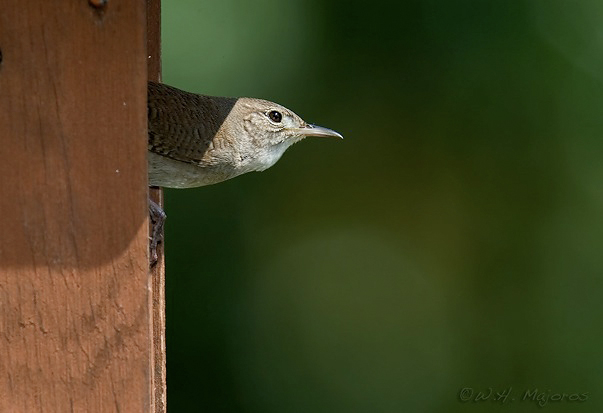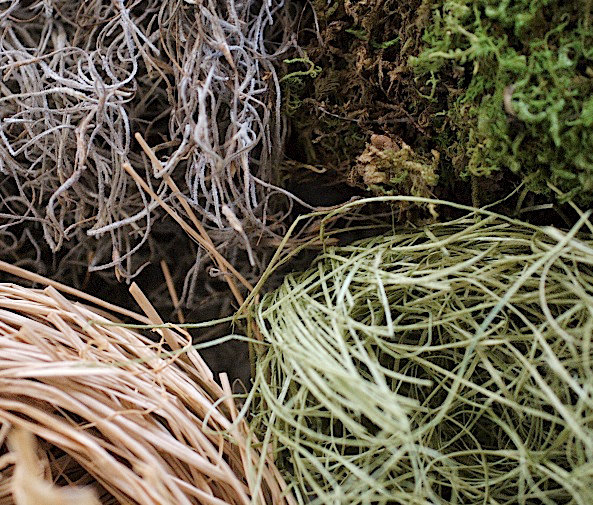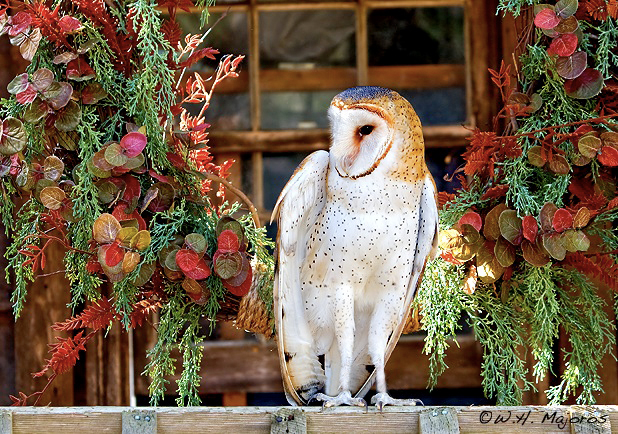|
9.2
Rustic
Embellishments
While perches and other substrates
provide places for the birds to loiter while you’re pursuing their
(digital) capture, there are a number of other props that you might
consider employing in order to spice up your images. The screech
owl (Otus asio) photo below
illustrates a number of these.
Fig. 9.2.1 :
Rufous-phased screech owl (Otus asio) perched amid a scene constructed
of natural
and artificial props. The bird is a rehabilitated animal on a
leg-leash, or “jess” (edited out of
the
image via Photoshop). Staff at the rehabilitation facility
utilized spanish moss, garland greens,
and a portable tree stump to construct the scene; the rectilinear
background colors are from
the visitor center building. Note that photo-ops like this can be
costly, but benefit the birds
housed at the facility. The event also gives them a chance to
escape their cages for a few hours.
This bird was
photographed during a photo-op put on by a local raptor rehabilitation
facility; the photo shoot cost $65 (US) per photographer, and lasted
about 4 to 6 hours. The staff at the facility placed various
photo props around the grounds of the facility, and then rotated their
captive birds between the photo settings. In this case, the tree
from which the owl is emerging was a small stump which was placed on a
table, and could easily be removed and carried away. On either
side of the stump you can see spanish moss that was draped over the
stump, and at the bottom of the image (in the foreground, but out of
focus) is a garland that was placed on the table supporting the
stump. In the background is some natural foliage, and behind that
is the out-of-focus coloration of the facility’s visitor center.
Hundreds or perhaps thousands of images like this one have likely been
crafted over the years at this facility alone, via the use of
natural-looking props (together with some creative framing on the part
of the photographer).
A good starting point for crafting a scene like this
in your own yard is the installation of an exotic perch or a
rustic-looking bird feeder or bird house. As previously
mentioned, bird houses serve not only as nesting cavities for birds
with such proclivities, but also as roosting sites for birds in other
months (particularly during colder months in the more extreme
lattitudes or altitudes). Birds can be productively photographed
perching on, entering, or leaving bird houses. Some birds will
mate at or on their adopted residence. The possibilities are
probably wider than you realize. Bird houses can be had very
cheaply, and can be either nailed to a tree or installed on a pole
(which can, unfortunately, cost significantly more than the bird house
itself).

Fig. 9.2.2 :
Wild house wren (Troglodytes aedon) emerging from a birdhouse.
Birdhouses provide not only nesting sites for cavity-nesting birds, but
also
sheltered roosting sites for wintering birds in your area.
Shooting an emerging
bird from the side produces a nice profile of the subject; in this
case, the bird appears
in front of a green background, thus offsetting the subject quite well,
while a frontal
shot would have placed the rufous bird in the midst of a scene
featuring a rufous
background, resulting in a far more cryptic composition (which may or
may not
be desirable).
When installing bird houses, be sure to keep the
available backgrounds in mind when choosing a location for
attachment. In particular, if you prefer out-of-focus backgrounds
then try to ensure that few objects appear close to the bird house from
likely viewing angles. In the figure below, the background is
nicely out-of-focus (though with enough intriguing shapes and color
gradients to give the viewer something to contemplate after s/he has
taken in the bird) because there were no trees or other structures
close to the birdhouse when seen from that angle.
Fig. 9.2.3 :
American kestrel (Falco sparvarius) perched on a nest box at
a raptor rehabilitation center. When installing nest boxes on
your property,
keep in mind the likely angles from which you’d be shooting birds
emerging
from the box or perching on top of it. Also, consider the ideal
opening
diameter, in terms of the types of birds that you’d like to include or
exclude
from entering the box.
For any given
substrate, there’s always the option of augmenting its appearance by
draping various epiphytes over it, or by draping them from a higher
support so that they dangle down to where the bird will be positioned
when you photograph it. Surprisingly enough, you can buy such
epiphytes from—you guessed it!—WalMart
and other commercial chains in their “home furnishings” department. The bag of
spanish moss shown below only cost me a few dollars (US), and provided
enough material to liberally cover a three-foot branch.
Fig. 9.2.4 :
Believe it or not, you can now buy spanish moss from your local
WalMart. The quality isn’t the greatest; what you’re getting is
actually “dead”
moss,
as opposed to the vibrant, living moss you might encounter in certain
natural habitats. Nevertheless, draping some of this stuff on
your branches
can potentially improve the scenery impact of your yardbird photos.
Besides the ever-popular spanish moss, there are a
number of other mosses, as well as grasses (and grass-like fibres such
as raffia and excelcior), that you can buy, by
the bag, from large chain stores. In the figure below, two
varieties of moss are shown at top while two grass-like fibres are
shown at bottom. These can be strewn in any number of ways on
perches—both natural and man-made—to improve the aesthetics of the
substrate with relatively minimal effort and cost.

Fig. 9.2.5 :
Four varieties of mossy or grass-like natural drapery that you can
apply to the perching substrates in your yard. Clockwise from the
10 o’clock
position: spanish moss, floral moss, aspen tree fibres, and
raffia. Keep in mind
that in some environments these will fairly rapidly degrade in
aesthetic quality
due to accumulation of mold and mildew; also, any wind may tend to blow
them
off of whatever substrate you’ve aplied them to. It’s also possible
to buy sheet moss
(not shown here), which can be laid over smooth surfaces.
I generally avoid the use of synthetic props such as
plastic flowers and the like, because when seen close-up they always
seem to look fake. For wider shots, however, you may be able to
get away with using these types of props. For the owl photo
below, the faux leafy branches were set up by the staff at a raptor
rehabilitation facility during a photo-op. Given the size of the
bird and the framing constraints, the plastic foliage ended up being
small enough that it’s marginally realistic-looking. I don’t
think I’d try this with small birds such as finches or warblers: the
requisite focal length would magnify any imperfections in the synthetic
material, likely resulting in unusable images.

Fig. 9.2.6 :
Barn owl posing amid plastic foliage. This captive bird was placed
by rehabilitation staff amid an artfully-constructed scene during a “photo op”. For
large subjects like this, plastic leaves and flowers may appear
realistic enough, but
for small birds more tightly framed, the amount of magnification
required to enlarge
the bird is also likely to enlarge any imperfections in the imitation
foliage.
Not all
man-made objects are equally objectionable to all photo viewers.
Rustic wooden props such as barrels and the like, which might easily be
found on any traditional farm, are often readily acceptable as photo
props for bird images. Wooden barrel-type planters are widely
available, and can serve both as unorthodox bird feeders and relatively
rustic perching substrates. I recommend drilling a hole in the
bottom, however, to avoid water build-up that might otherwise foster
the breeding of mosquitos, and can also result in seed-rot (if you’ve
deposited seed in the vessel).
Fig. 9.2.7 :
Tufted titmouse (Parus bicolor) perched on the rim of a barrel planter
purchased at WalMart. A bit of seed deposited in the bottom of
the barrel will attract
birds, but making sure that water can drain from the vessel is
important in making
sure that the seed doesn’t rot, and that mosquitos don’t end up
breeding within.
|
|
|
